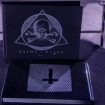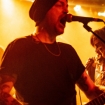For many heavy-music fans, Quicksand were their post-hardcore entrypoint. Fronted by Walter Schreifels, also of Gorilla Biscuits and Rival Schools, the NYC band's groundbreaking 1993 debut, Slip, melted the barriers between hardcore, metal, grunge and more, offering a new strain of heavy that pushed the foundation laid by Rites of Spring and Fugazi into breathtaking new directions.
To this day, Quicksand — and Schreifels especially, as their spokesman and creative mastermind — are revered as one of post-hardcore's most important acts, and in honor of Slip being reissued by Iodine Records to celebrate its 30th birthday, we had Schreifels flip through post-hardcore's knotty history and rank his 10 favorite releases in that canon. From groundbreaking 80s originators to genre-bending 90s innovators, read what he picked and why below.
10. Thursday - Full Collapse
Because of when this record came out in 2001, Thursday are mostly grouped in with emo or its unhinged sibling genre screamo, but I'm here to officially claim them as a post-hardcore outfit. I remember meeting the Thursday guys at the time of Full Collapse and being energized by their re-imagining of that ultra-thin slice of musical territory between hardcore and something outside the lines of it.
With every member creatively contributing, there's always an amazing time change or dynamic shift to draw you in that just wouldn't happen in a less democratic band. Like Fugazi, they seem to draw from the power of the sum of their parts. The song that really grabs me is "Understanding in a Car Crash," with Geoff Rickley's anthemic delivery of "I don't want to live this way forever" — I still hear echoes of the Revolution Summer.
9. Shudder to Think - Funeral at the Movies
While reading these back, I can see my perspective on post-hardcore is very [based in] Washington D.C. and mid-to-late-1980s heavy. I know there're tons of great bands from other parts of the country and time periods that should and could be acknowledged in this list, but who's to say they'd want to be? Anyway, I'm running with the bands that had the most effect on me as a hardcore kid looking for new ways of doing it, and Shudder to Think's Funeral at the Movies definitely struck a chord with me.
The track "Chocolate" starts off like lots of punk records before it, but you soon find out they've only been playing with you, as Craig Wedren's wonderfully unique melodies and androgynous delivery foil your expectations completely. My favorite track and one of my fave songs of all time is "Red House"; it's Shudder to Think's "Waiting Room," and it should be on every jukebox in America. Speaking of America, something I admired most about Shudder to Think is how Craig Wedren plays with androgyny. There are definitely traces of Bowie and Morrissey throughout, but his sense of melody is totally unique to him.
8. Girls Against Boys - House of GVSB
Seems crazy, I know, but I didn't realize how male-dominated hardcore was at first. I guess I was just into the aggression and energy of it, but after a while I began to wonder why there weren't more girls into it or doing their thing. Girls Against Boys recognized and addressed this imbalance by reminding everyone that a good groove is welcoming to all. Rather than screaming over the top, Scott McCloud's vocals are like Richard Butler of Psychedelic Furs if he was a hardcore singer.
A lot of what gets tagged as post-hardcore is notable for its expansive emotional content or musical experimentation, whereas GVSB songs like "TheKindaMzkYouLike" and "Super-Fire" simply brought sexy back to post-hardcore — and made it better for everyone.
7. Rage Against the Machine - Evil Empire
Rage Against the Machine singer Zack De La Rocha came up in the Orange County hardcore scene and was a big fan of Dischord Records, and it shows on this album. Where their first record is more hip-hop and rock oriented, Zack's delivery on Evil Empire [owes] as much to Guy Piccioto as Chuck D. Check songs like "Snakecharmer" or "Without a Face" — they track with Fugazi's sound of that era. Like the Clash serving punk through Combat Rock, Evil Empire is a case of the masses ingesting hardcore but not knowing it. It's like when I give my dog her heart medicine covered in peanut butter.
6. Helmet - Strap It On
Helmet formed from an ad in the Village Voice, which is kind of amazing. The Voice was the free alternative weekly newspaper in New York, and people would pay for little classified ads for one kind of person "seeking" another like them, like in Desperately Seeking Susan. Helmet had some No Wave pedigree to them via Page Hamilton's collaborations with avant-garde composer Glenn Branca, bit despite that, Helmet's music and imagery appealed seamlessly to hardcore kids. Drummer and youngest member, John Stanier, was a legit hardcore kid who answered the ad in the Voice. Their look was clean-cut, tall and sporty, like a youth crew band save for guitarist Pete Mengede, who brought a refreshing touch of Nick Cave vibe with him from his native Australia.
Strap It On is raw, loud and fast, but also effortlessly smart, fun and precise at the same time. "Sinatra" is an otherworldly mosh anthem, "Bad Mood" sounds like a nine-year-old screaming, "It's not fair!," during a pissy tantrum. Seemingly basic on the surface, Strap It On is like hardcore as if conceptualized and drawn by MC Escher.
5. Jane's Addiction - Nothing's Shocking
I can see myseflf getting some push back on this one — "Hey, they're not hardcore!" — but I'm including them anyway, more for their influence on post-hardcore bands than being post-hardcore themselves. Though to be fair, Jane's members had punk backgrounds; their first record came out on Triple X Records and they were on the label the same time as the Vandals, Social Distortion, the Adolescents, among others. Despite their big rock-ness, Jane's still managed to convey a DIY ethos that could be felt throughout the Nothing's Shocking era; conveying a sense that they existed outside of the [mainstream] music industry.
Whether on the massive opening track "Mountain Song" or the more delicate classic, "Jane Says," Jane's Addiction were fearlessly down to go in any creative direction both because of and perhaps despite their punk background. In either case, Nothing's Shocking was a major touchstone inspiration for friends looking for new musical inspirations beyond hardcore.
4. Dag Nasty - Can I Say
I wish I had seen Minor Threat live. I missed them by just a couple years, years that felt like decades judging by the xeroxed black and white photographs of bands in 1983 that looked like they were taken at the turn of the century. While I waited in vain for Minor Threat's return, Dag Nasty took the scene by storm in what appeared to be the next best — or possibly better — thing. Featuring Minor Threat alum Brian Baker and Ian MacKaye himself producing at Inner Ear Studios, where all the early Dischord classics were recorded, added to the amazing vocal performances by Dave Smalley of Boston's DYS. All the hardcore boxes were checked.
Can I Say delivers on all the Minor Threat-ness in the best way, as an evolution rather than a retread. It felt like it could have been the record Minor Threat might have made had they continued. With anthems like "Values Here" and emo-esque bangers like "Circles," Can I Say showed how far hardcore could be stretched and still hold its shape.
3. Hüsker Dü - New Day Rising
Hüsker Dü played fast and loud. That was their thing, making their initial mark with Land Speed Record on SST Record,s founded by Greg Ginn of labelmates Black Flag. While Hüsker Dü were initially attracted to the aggression and free wheeling-ness of hardcore, deep down they were fans of '60s pop. This began to show itself with their amazing cover of "Eight Miles High" by the Byrds and the equally great B-side of the Mary Tyler Moore Theme.
1985's New Day Rising was when they committed to this new direction. "The Girl Who Lives on Heaven Hill" shreds like their past hardcore songs, with little moments of chugged metal like the Cro-Mags, but with a sense of song structure that shows their love of pop singles. "59 Times The Pain" is another rager with great lyrics and pronounced melodies that still made sense to hardcore punk kids. As they progressed, they got further away from that traditional hardcore aggression, but on New Day Rising they're still in hardcore's orbit.
2. Rites of Spring - Rites of Spring
Rites Of Spring is foundational to all things post-hardcore and emo; two descriptions that reduce the originality and flatten the influential import, but there's limits to language and I've been asked to keep it to a few sentences. Released in 1985, RoS epitomizes the best of what was known in D.C. as the "Revolution Summer." It was a time where all of the musicians who had formed the early creative fabric of Dischord Records seemed to simultaneously freak out in the best way, and flip the script on what had been known as the D.C. sound.
Singer Guy Picciotto (who would later go on to co-found Fugazi) had a very new and unique delivery, super energized but not in an aggressive way. There was melody around the edges but nothing sugary; suggesting a greater depth of emotional range than you'd expect from a hardcore band. Legend had it that instead of moshing like normal punks, people cried at Rites of Spring shows. Songs like "Deeper Than Inside" or the opener, "For Want Of," are artfully untethered to any script. The lyrics are more poetic than hardcore, but the emotions behind them are every bit as palpable as Minor Threat.
1. Fugazi - 7 Songs
Dropping the needle on "Waiting Room" for the first time exceeded all expectations, an instant paradigm shift. It's smart, fun, philosophical, innovative yet familiar elements of reggae and post-punk, re-purposed to create something completely new.
I wore the grooves out of that one, but while writing this list out now, my favorite song on that EP is "Bulldog Front." Over their amazing and diverse career, it's the Beatles-esque quality of Fugazi — with the sum being greater than its parts — that "Bulldog Front" delivers directly on the heels of "Waiting Room." While I expected Ian MacKaye to be the focus, I loved Guy's voice here for its passion and panache, previously unheard of in hardcore.
They never needed to write another "Waiting Room," it was the chemistry between them that made Fugazi so exciting and creatively boundless over the years. "Post-hardcore" is an extremely reductive term, especially in this case, but to me, this first EP is ground zero for whatever's great about the genre.








